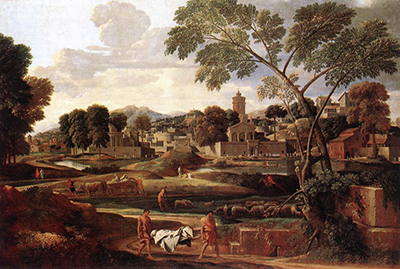The Funeral of Phocion is a landscape painting on an oil canvas material paint done in 1648 in Athens. The landscape in the picture is an integral part of the art.
The composition of the paint, the way different aspects of the paint have been put together, has been carefully and strategically arranged to direct the viewer's eyes through and around the picture. In The Funeral of Pocion paint, what draws the attention of the viewer immediately is the white shroud and the figure of the body at the bottom center of the painting. This is also the main content and theme of the paint. Then, almost subconsciously, the viewer's eyes move on the path on which they have come along, a criss-cross road, into the drawing, back through the vast well-depicted fields, towards the town and further in the distance.
The wild and unattended land on the foreground of the paint, The Funeral of Phocion, on the left side leads the admirer of the paint to the more engaged pastoral activities in the middle and further behind a town with figures scattered is seen. There is rhythm in the paint in the repetition of shapes and colors. The shapes of the trees are repeated and the red attire worn by the people moves the eye from one scene to another. The figures in the paint seem to go on their daily chores unbothered by the dead body been moved. The viewer is also given the opportunity to look into the people's daily life through the portrayal of villagers bathing, playing instruments, praying and tending to animals. The illusion of distance in the picture is created through perspective. The objects in the distance appear smaller and become bigger through the middle up to the foreground of the paint The Funeral of Phocion.
Also, the use of lighting is clearly brought up in the paint. The colors used in the background are brighter compared to the darker, warmer tones in the front. The contrast in the colors helps create drama and also highlights the area as it makes some other parts look mysterious. the figure riding a horse, for example, can be seen coming out of darkness making the viewer want to know the details of the concealed parts. Nicolas Poussin was profoundly influenced in his work by painter Raphael and Giulin Romano. Among artists influenced by him include Jacques Stella, Eugene Delacroix, and Jean Hugo.




